BILL'S SOMEWHAT WEEKLY BLOG
|
|
Since I seem to have lost my forum, Mark
Thomas' "Racin' Paper", I will apparently enter the 21st Century and start doing
my column as a
blog. In certain times of the year, this may not be weekly; but I promise to
keep it regular. Many of the site regulars have only been able to
get my columns via this site, anyway, and representing the very newspaper that
was given out at Thunder Road gave me no press courtesies.
So, I might as well do it this way and reach some different readers. Let me know
what you think. -Bill
Week of Sept 10, 2012
|
|
HEADIN’ NORTH IN EARLIER TIMES
When many race fans think about crossing the border into Canada for the purpose of racing, today’s fan thinks of such things as the American – Canadian Tour, dirt modifieds over by Ontario, difficult crossings at customs, and people like Patrick LaPerle or maybe Tim McCreadie. But, years before any of this [or them], when the crossing into the Dominion was much easier, there was considerable traffic, both to and from the land of the maple leaf to race or view racing.
I have been hearing stories from my 88 year – old buddy, Jackie Peterson about when he would venture into Quebec with his car # V1 to race on a rather extensive basis. I am also aware that, in the next decade [the 1960’s] NASCAR thought enough of the possibilities of the rich racing environment – especially around Montreal – to sanction some tracks there around 1962 and 1963.
Courtesy of C.J. Richards
Jackie Peterson, then
running his Bodah’s Diner V1 out of Massena, NY, was
one of the most familiar
American faces in Quebec for many years.
Around 1950 and 1951, there were some mighty interesting racing arrangements being made at some fairly odd venues. The Montreal area was full of majestic old horse racing tracks, most with large grounds, dirt tracks, and nice, big covered grandstands. And, unlike their counterparts south of the border, they were not afraid to use these facilities to stage motor contests of various sorts. In the heady days of the early fifties, there are records of motorcycle racing, sprint car racing, midgets, and a wide variety of what would be considered stock car racing.
Peterson Collection Photos
Jackie Peterson’s #16
sprinter sits in a lineup at Richelieu Park around 1950. Notice the place at
left where bets could be placed. [Below] Peterson, temporarily in the rear,
chases the Canadians’
big anti – hero, Art Prairie, at a track in Sheldon, VT.
Tim Flock Homepage Photo
Jackie’s first initiation to Canadian racing was with his sprint car; and, chances are, that was the first Canadian racing available to any Americans. Jackie speaks of performing at Richelieu Park, a lovely setting off Rue Sherbrooke , to which he hauled with a number of other American drivers belonging to what the newspaper Le Canada called L’Association de Courses d’Autos Adirondacks [The Adirondack Racing Club, I suppose]. The group, led by 64 year – old President and active driver Paul A. [Pa] Soper.
New York sprint car driver Art Prairie, according to Peterson and to newspaper articles, became the hot property of Canadian promotion. A number of Richelieu Park promo news stories touted match races between Prairie, who would become best known in New York as a flagger, and local star Roger Charron. My limited ability to read French indicates that track management reached out to P.A. Soper, who arranged with Prairie to have a number of “les match specials” at Richelieu Park. Although the size of the open wheel fields was somewhat limited, the races were apparently spirited. Peterson tells of one time when Prairie’s car took out over one hundred feet of the wooden fencing along the side of the beautiful horse racing facility. Wryly smiling, he added that, not too long after that, there weren’t any more races for a awhile.
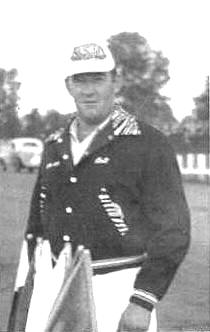
Bob Mackey Photo Courtesy of John Rock
Somewhat crazy as
driver, Art Prairie was almost as unpredictable as a flagger. His connection
to “Mme Northy” is mysterious.
The New York contingent, which included South Burlington, VT native Peterson, included P. A. Soper, his son, Phil [known as Squeak], Prairie, Eddie Elliott, of Fair Haven, VT., Charles Sharrow, a Soper neighbor, and Donald Frazier, of Albany. Several article mention a “Mme Northy Prairie” as a driver, supposedly from Plattsburgh. There is no indication who she is or what her relationship was to Art. Canadian drivers, besides Charron, included Johnny Kovacs and Donald Disso.
Soon thereafter, the Richelieu Park ads seem to be more about stock cars; although there is little mention of American drivers. About the same time as Richelieu made a brief switch over to stock cars, so did Jackie Peterson; but, he never mentioned running at that particular venue. Stock cars were tried all over Quebec, especially in the Montreal area. Tracks would come and go as often as they did in New York and New England. However, a few tracks showed enough promise to attract the attention of NASCAR by the early 1960’s. Before that, however, a number of northern Vermont drivers were making regular runs to Canada to run stock cars in the 1950’s.
Peterson Collection
Second generation
sprinter Phil “Squeak” Soper made a name for himself all over the Northeast,
but disappeared when stock cars took over in the 1950’s. [Below] Gustave
Bouvrette, [one of men at right] actually started race cars with this horse
gate.
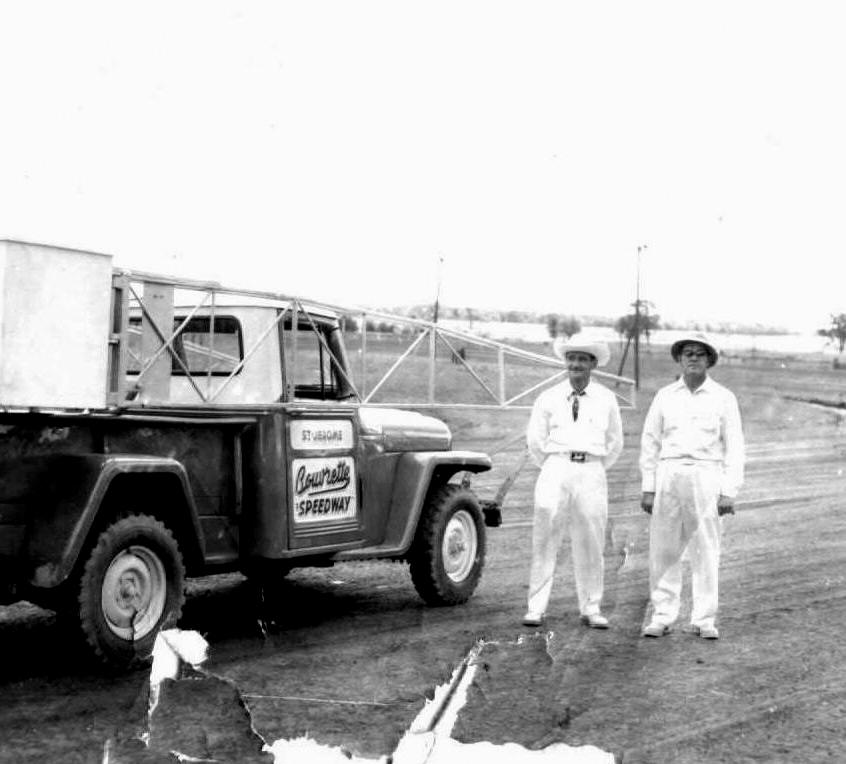
Courtesy of Andre Chausse
Courtesy of
Gerard Major, via Roger LaBreche, Jr.
Bouvrette
Speedway, 1957. The white Jeep is in the midst of the race cars with the horse
gate closing.
The Montreal suburb of LaPrairie seemed to be the same kind of hotspot for early stock car tracks as Colchester, a Burlington, Vermont suburb was further south. It is somewhat confusing to talk to the older guys about that time because they tend to lump all the LaPrairie tracks together as “LaPrairie”. In fact, the township had Kempton Park, at one time, and the Noel Speedway at another. Kempton Park had begun, around 1951 in a partnership with Richelieu Park, under the sponsorship of E.Provencher.
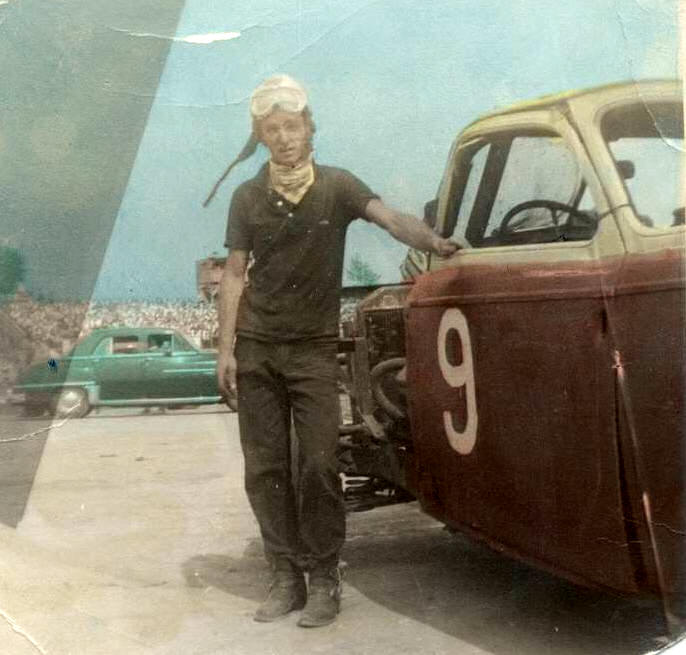
Courtesy of Gerard Major via Pascal Cote
Website
Gaeton DiPietro, one of
the Kempton Park Speedway local runners, poses with his typical – looking car
around 1951. They weren’t much for keeping body configurations intact here or
at Bouvrette. Below - This is a typical
heavily - modified Bouvrette entry [early Quebec legend Gilles Brochu] .
American cars were comparatively conservative to these.
Courtesy of
Gerard Major, via Roger LaBreche, Jr.
That early version of Kempton Park, under Provencher, promoted a rivalry between the invading Glens Falls, NY team of Wally LaBelle and the local Quebec drivers of the Montreal area. One local sponsor, Tougas Automobile of St. Jean, even put a $1,000 bounty on the head of LaBelle for a local who could beat him and his yellow Vern Baker – owned 6 PAC Hudson coupe. LaBelle, at that time, was splitting time among Kempton Park, Ashland Park in Warrensburg, NY, Whites Beach Speedway near Saratoga, the Fairmont Park Motor Speedway in Fair Haven, VT, and Stateline Speedway, near Bennington, Vt.
Courtesy of the Hackel Family
Wally LaBelle was best
known for his performances in the 6 PACK, a yellow 1934 Hudson that came
out
of Warrensburg, NY. This is at Ashland Park Speedway, in Warrensburg.
This LaBelle promotion was needed, as the best – established and most successful track of that era was operating in St. Jerome. Bouvrette Speedway, located at another majestic old pari-mutuel horse racing venue, was seeing large fields race in front of huge crowds of “spectateurs”. Gustave Bouvrette had managed to kick off the careers of everyone from Jean-Paul Cabana, to Jean Guy Chartrand, to Andre Manny and more.
Jackie Peterson and a few of his buddies had put some time at Bouvrette, where the local cars were very odd – looking rigs. But the sheer numbers of local teams made it difficult to make much money there. Future NASCAR National Sportsman co Champions, Dick Nephew and Bill Wimble, would both race at Bouvrette. Nephew, from the predominantly French Canadian hamlet of Cannons Corners, NY, was equally at home in Quebec, with his pronounced French accent and his many local relatives. Wimble, on the other hand, being decidedly English, was not as comfortable.
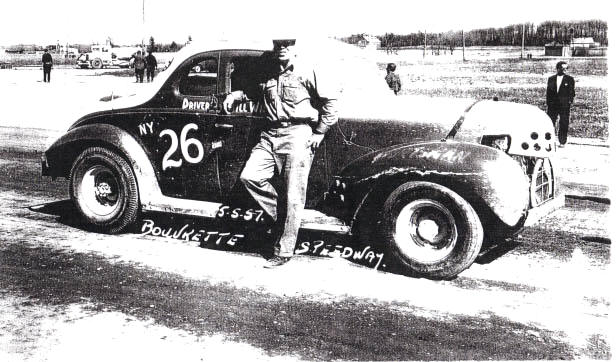
Courtesy of Craig Revelle
Bill Wimble, then from
Lisbon, NY and running out of Gaylord Rowe’s racing stable, ran Bouvrette
around 1956. [Below] Dick Nephew would also run Bouvrette, where he would
first oppose perennial rival Jean – Paul Cabana, who started there. He kept
this shot of JPC in his own collection. The young Cabana was there against the
wishes of Pere Cabana.
Courtesy of Gary Nephew
The hard – of –hearing Peterson could care less if he fit in or not – he couldn’t hear anyone anyhow. Bouvrette used to start the cars with the same gated truck that they started the horses with. He recalls, one time, accidentally stuffing one of the other Vermont cars under that gate because he hadn’t waited for Bouvrette’s Jeep pickup truck, carrying the closing gate structure, to get out of the way. It is highly liely that happened on a regular basis.
Kempton Park went through another promoter in 1952 named R. Benoit, operating under the banner of the Montreal Stock Cars Racing Company. By 1953, the track, running under the Eastern Stock Car Racing Association, promoters Rene Boileau and a man named Gevry. By this time there was competition from another track being built not very far away. Roger Noel, with support from brother, Eugene, broke ground in 1953 on a site listed as “off Taschereau Boulevard”. Noel Speedway would offer another place for roving American teams to try their luck in the mid 1950's.
Courtesy of the Owen Family
Gordy Owen [2nd
from left] poses with Roger and Eugene Noel at their track as Mrs. Owen
gets
to sit in the race car. Owen’s car 31 was a winner all over the region.
By this time, the American contingent had stopped doing much traveling to St. Jerome. LaBelle had settled into racing in New York; and Peterson had attracted a number of his Vermont racing rivals to try their hand in LaPrairie: Alburgh, VT’s Frank Hart and Chuck Westover; Ronnie Cooley, from Barre, VT [a future co - owner of both Thunder Road and Catamount Stadium]; Rex Shattuck, from Burlington, VT; Myron “Rollover Ronnie” Farnsworth, of Fort Ethan Allen; Lloyd Brown, from Swanton, VT; and Richford, Vermont’s Harrison King. Other articles mention Peterson’s friend, Billy McDonald, from Milton, VT, as well as Dick Bohannon, of Alburgh as others who made the haul to LaPrairie. Arguably, the most successful runner at these tracks was Williston, Vermont’s Gordie Owen, who not only ran at Bouvrette and Kempton Park, but who was spotlighted by Noel as the big guest star at his race track.
Peterson Collection
Jackie Peterson [left]
and Frank Hart [center] have a post – race beer at one of their home tracks,
Green Mountain Speedway in Sheldon, VT, right around 1952. They, and crewman
Ernie Haskins at right, were also in Canada frequently that season.
As stock car racing, in general did, the stock car racing in this region went through a sort of dry spell throughout much of the rest of the 1950’s. With the rise of the Malletts Bay Raceway, in Vermont and the Airborne Park Speedway near Plattsburgh, NY, the Americans pretty much stayed home for the remainder of the decade. By the early years of the 1960’s, with NASCAR national points becoming a very important factor in New York sportsman racing, a new invasion would occur for a couple of seasons.
NASCAR moved into the Greater Montreal area, perhaps due to the rise of local stars Jean – Paul Cabana, Andre Manny, Jean Guy Chartrand, and others. By 1962, NASCAR tracks included the little – known Autodrome – de – la _Maorce, in Mont-Carmel; Riverside Speedway, in Laval; Fury Speedway, in Fabreville; and the still – surviving Kempton Park. The little circuit had a strong core of local sportsman teams to oppose Cabana, Manny, and Chartrand: Jerry Gagnon, Montreal; long-time veteran Gilles Brochu, from Chomedy; Dick Foley, from Montreal; Marcel Godard, Montreal; Albert Angel, another veteran, from Montreal; and Real Croteau, from Jacques Cartier, were among these.
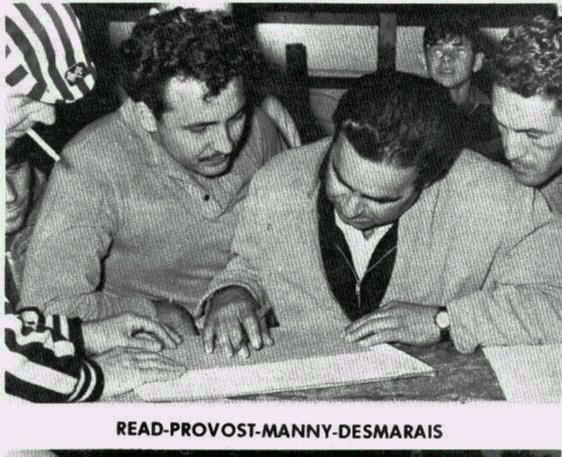
Bob Mackey Photo via Cavalcade of Auto
Racing
Checking the final
results at Riverside. [From left] Ernie Reid, Harry Provost, Andre Manny, and
Gaston Desmarais were all key players in the Quebec / NASCAR point chases of
the early ‘60’s.
The early 1960’s were the zenith of points chasing efforts for northern New York sportsman teams. Wimble had won the national championship in 1960, and he tied with Nephew for the honors in 1961. By 1962, the familiar New York teams who always dominated the points were getting heat from the soon – to – be four –time National Champion Rene Charland, running out of Agawam, Massachusetts at that time. While realizing that the competition north of the border was stiff, and that their presence there was not entirely appreciated by a somewhat mafia – influenced Montreal racing community, a number of Airborne regulars did run up there for points in 1962 and 1963.
Cabana, then operating right out of LaPrairie, would finish second to Charland in the NASCAR national sportsman points in 1962. Right behind them would be Wimble, whose racing emphases had pretty much pulled him out of his native northern New York by that time. Nephew finished eighth, right in front of Manny and Chartrand. Brochu managed 19th overall. Of all the New York sportsman invaders, the largely – accepted Nephew did the best in Quebec. He managed to finish 12th in the Canadian “State” standings, two spots ahead of the massive Cadyville, NY driver Harry “The Head” Provost, who didn’t care if he was accepted or not. [No one was going to give him much crap]. Massena’s Ernie Reid, another Airborne regular, came in right after Provost.
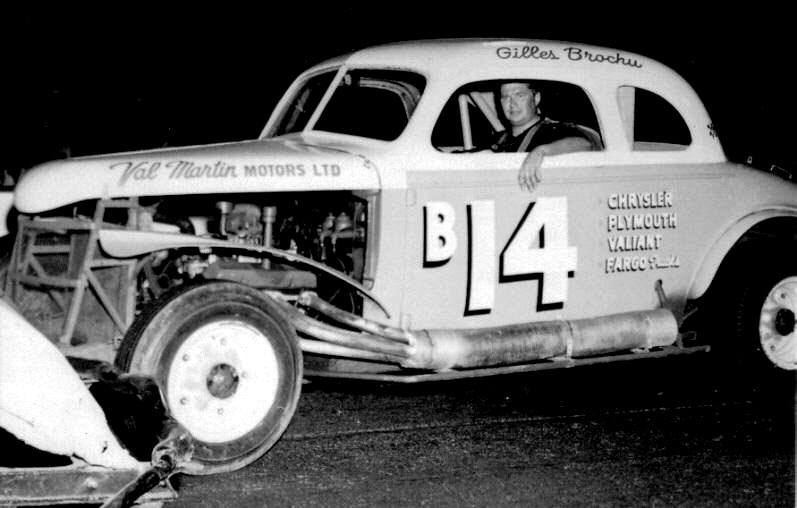
Courtesy of Mike Watts, Sr.
In the somewhat
shady atmosphere of Montreal region racing, apparently someone appreciated
neither Gilles Brochu’s long race career nor his great points finish in 1962.
He ended up in an exploding car outside a Quebec night spot.
None of the New York drivers ever took a NASCAR points title at these Canadian tracks. Nephew managed fifth at Kempton Park, in what looked like a modest four or five – race schedule. Reid finished sixth at Riverside [just ahead of Nephew] at an even – more – limited slate of races.1963 results were not available. In 1964, Wimble again chased Charland across the finish line for the national title, although Da Champ was ahead by over 2,000 points. Nephew, Provost, and some others continued to run at Riverside. Cabana, who managed a 20th place national finish saw team mate Paul Hamel win the Canadian title in 1964. Chartrand was starting to spend more time on New York tracks and we were one year away from Catamount Stadium and Thunder Road siphoning off many of the Quebec sportsman teams.
Today, running in Canada is more complicated and less desirable to most NASCAR runners. The days of wandering, almost – professional stock car drivers like Jackie Peterson and Gordie Owen, both of whom had fathers who allowed for creative work hours at machinery – related businesses, is long over. Peterson, who still hangs around the races at Airborne, at age 89, shakes his head and says those nights when he would leave somewhere like Kempton Park or Bouvrette, towing back the race car while his car owner “made stops” elsewhere to see if he could reduce the Canadian national beer reserves, are over. For one thing, Jackie laughs, he was sick of having the owner’s wife blame HIM for the shortages in that family’s budget. Second, today, the money doesn’t equal the overhead and it’s a damned pain getting across the border.
Peterson Collection
Jackie [left] would
take the 6 7/8 home and catch hell from Mrs. Palmetier. George would
stay behind and make sure there wasn’t too much dangerous beer left in Quebec.
Please email me if you have any photos to lend me or information and corrections I could benefit from. Please do not submit anything you are not willing to allow me to use on my website - and thanks. Email is: wladabou@comcast.net . For those who still don’t like computers - my regular address is: Bill Ladabouche, 23 York Street, Swanton, Vermont 05488.
Return to the Main Page
Return to the Main News Page
Return to the All Links Page
Return to the Weekly Blog Links Page